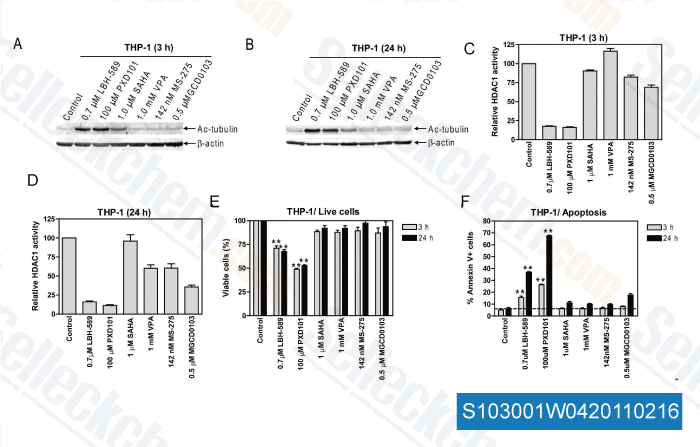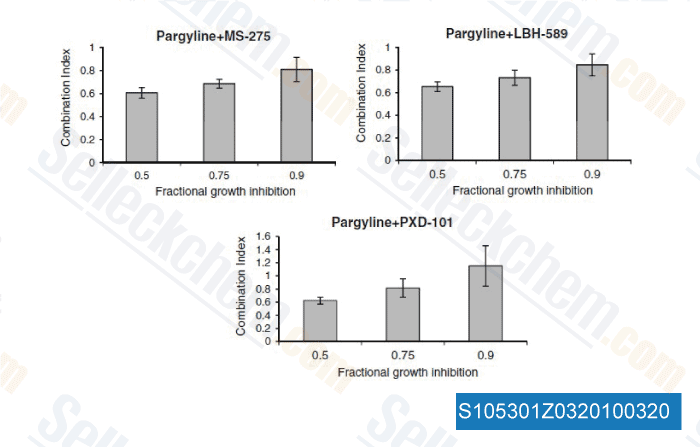|
Toll Free: (877) 796-6397 -- USA and Canada only -- |
Fax: +1-832-582-8590 Orders: +1-832-582-8158 |
Tech Support: +1-832-582-8158 Ext:3 Please provide your Order Number in the email. |
Technical Data
| Formula | C15H14N2O4S |
||||||||||
| Molecular Weight | 318.35 | CAS No. | 866323-14-0 | ||||||||
| Solubility (25°C)* | In vitro | DMSO | 64 mg/mL (201.03 mM) | ||||||||
| Ethanol | 64 mg/mL (201.03 mM) | ||||||||||
| Water | Insoluble | ||||||||||
| In vivo (Add solvents to the product individually and in order) |
|
||||||||||
|
* <1 mg/ml means slightly soluble or insoluble. * Please note that Selleck tests the solubility of all compounds in-house, and the actual solubility may differ slightly from published values. This is normal and is due to slight batch-to-batch variations. * Room temperature shipping (Stability testing shows this product can be shipped without any cooling measures.) |
|||||||||||
Preparing Stock Solutions
Biological Activity
| Description | Belinostat is a novel HDAC inhibitor with IC50 of 27 nM in a cell-free assay, with activity demonstrated in cisplatin-resistant tumors. Belinostat (PXD101) induces autophagy. | ||
|---|---|---|---|
| Targets |
|
||
| In vitro | Belinostat inhibits the growth of tumor cells (A2780, HCT116, HT29, WIL, CALU-3, MCF7, PC3 and HS852) with IC50 from 0.2-0.66 μM. PD101 shows low activity in A2780/cp70 and 2780AD cells, which are cisplatin and doxorubicin-resistant derivatives of A2780 cells. Belinostat could induce apoptosis through PARP cleavage and acetylation of histones H3/H4. [1] Belinostat inhibits bladder cancer cell growth, especially in 5637 cells, which shows accumulation of G0-G1 phase, decrease in S phase and increase in G2-M phase. [2] The growth inhibitory activity of belinostat on cell lines is not strongly influenced by the multidrug-resistant phenotype, whereas the activity of docetaxel is clearly affected. Belinostat could enhance the growth inhibitory activity of docetaxel or carboplatin in OVCAR-3 and A2780 cells. Belinostat also shows enhanced tubulin acetylation in ovarian cancer cell lines. [3] A recent study shows that Belinostat activates protein kinase A in a TGF-β signaling-dependent mechanism and decreases survivin mRNA. [4] | ||
| In vivo | Belinostat indicates significant tumor growth delay in A2780 and A2780/cp70 xenograft at a dose of 10mg/kg with no effects on the body weight. [1] Belinostat also induces p21WAF1, HDAC core and cell communication genes in mouse bladder tumors. [2] Belinostat monotherapy induces dose-proportional antitumor effects with TGI of 47% at a dose of 100mg/kg in A2780 xenograft. The combination of Belinostat (100 mg/kg) with carboplatin (40 mg/kg) could delay tumor growth from 18.6 days to 22.5 days. [3] Combining with bortezomib, Belinostat results in great tumor inhibition and gastrointestinal toxicity in mice with bortezomib-resistant UMSCC-11A xenograft. [5] | ||
| Features | Lead compound of Topotarget. |
Protocol (from reference)
| Kinase Assay:[1] |
|
|---|---|
| Cell Assay:[1] |
|
| Animal Study:[1] |
|
References
Customer Product Validation

-
Data from [Breast Cancer Res Treat , 2012, 131, 777-789]

-
Data from [PLoS One, 2011, 6, e17138]

-
Data from [PLoS One, 2011, 6, e17138]

-
Data from [Breast Cancer Res Treat, 2010, 131(3), 777-789]
Selleck's Belinostat has been cited by 98 publications
| Chronic hypoxia stabilizes 3βHSD1 via autophagy suppression [ Cell Rep, 2024, 43(1):113575] | PubMed: 38181788 |
| Establishment, characterization, and biobanking of 36 pancreatic cancer organoids: prediction of metastasis in resectable pancreatic cancer [ Cell Oncol (Dordr), 2024, 10.1007/s13402-024-00939-5] | PubMed: 38619751 |
| Aberrant JAK-STAT signaling-mediated chromatin remodeling impairs the sensitivity of NK/T-cell lymphoma to chidamide [ Clin Epigenetics, 2023, 15(1):19] | PubMed: 36740715 |
| Defining cellular responses to HDAC-selective inhibitors reveals that efficient targeting of HDAC3 is required to elicit cytotoxicity and overcome naïve resistance to pan-HDACi in diffuse large B cell lymphoma [ Transl Oncol, 2023, 39:101779] | PubMed: 37865047 |
| Single-cell profiling-guided combination therapy of c-Fos and histone deacetylase inhibitors in diffuse large B-cell lymphoma [ Clin Transl Med, 2022, 12(5):e798] | PubMed: 35522945 |
| Dual Blockade of Misfolded Alpha-Sarcoglycan Degradation by Bortezomib and Givinostat Combination [ Front Pharmacol, 2022, 13:856804] | PubMed: 35571097 |
| Dual Blockade of Misfolded Alpha-Sarcoglycan Degradation by Bortezomib and Givinostat Combination [ Front Pharmacol, 2022, 13:856804] | PubMed: 35571097 |
| Establishment and Characterization of NCC-PMP1-C1: A Novel Patient-Derived Cell Line of Metastatic Pseudomyxoma Peritonei [ J Pers Med, 2022, 12(2)258] | PubMed: 35207746 |
| Establishment and characterization of NCC-UPS4-C1: a novel cell line of undifferentiated pleomorphic sarcoma from a patient with Li-Fraumeni syndrome [ Hum Cell, 2022, 10.1007/s13577-022-00671-y] | PubMed: 35118583 |
| Somatostatin receptor 2 expression in nasopharyngeal cancer is induced by Epstein Barr virus infection: impact on prognosis, imaging and therapy [ Nat Commun, 2021, 12(1):117] | PubMed: 33402692 |
RETURN POLICY
Selleck Chemical’s Unconditional Return Policy ensures a smooth online shopping experience for our customers. If you are in any way unsatisfied with your purchase, you may return any item(s) within 7 days of receiving it. In the event of product quality issues, either protocol related or product related problems, you may return any item(s) within 365 days from the original purchase date. Please follow the instructions below when returning products.
SHIPPING AND STORAGE
Selleck products are transported at room temperature. If you receive the product at room temperature, please rest assured, the Selleck Quality Inspection Department has conducted experiments to verify that the normal temperature placement of one month will not affect the biological activity of powder products. After collecting, please store the product according to the requirements described in the datasheet. Most Selleck products are stable under the recommended conditions.
NOT FOR HUMAN, VETERINARY DIAGNOSTIC OR THERAPEUTIC USE.
